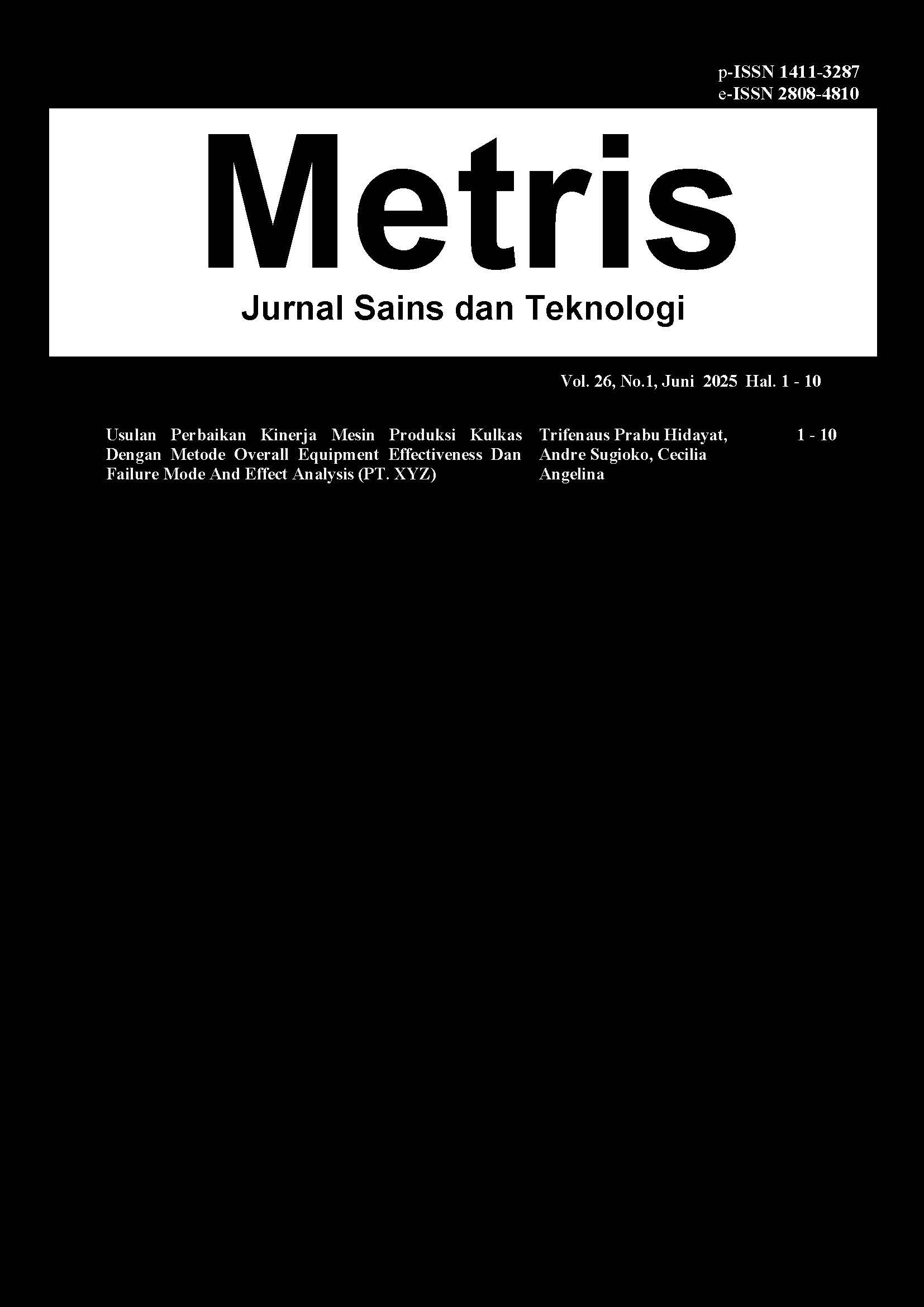Analisis Penggunaan Earbuds atau Earphone di Telinga Saat Berkendara Roda Dua
DOI:
https://doi.org/10.25170/metris.v26i01.7193Keywords:
Earphone, Earbuds, Pengendara Sepeda Motor, KenyamananAbstract
Using earphones or earbuds while driving positively and negatively impacts the driver. Congestion is a condition that causes motorists to use these hearing aids. However, the use of hearing aids while driving can threaten the safety of drivers and other drivers. The Bumi Serpong Damai (BSD) area is an area with many motorcyclists, so it can be a reference for motorists to pay attention to the dangers of using earphones while driving. Using earphones while driving, motorcyclists often do not focus on road conditions. Moreover, motorists can be indifferent to signs and other motorists. Therefore, a study was conducted on the use of hearing aids by two-wheeled riders in the BSD area to reveal the underlying problems associated with the use of hearing aids when driving. This study was conducted through the distribution of questionnaires and data processing using the chi-square test and logistic regression. This study aimed to determine motorcyclists’ level of awareness about the dangers of using earphones while driving. The result showed that a relationship exists between the frequency of use and driving comfort; the dominant factor affected by using hearing aids while driving is a reduction in emotions due to traffic jams. This study recommends that the government address traffic congestion due to its strong impact on driver emotions. For motorcyclists, it is advised to keep the earphone volume low to maintain focus on traffic signs and surrounding sounds.
References
Ananda, & Anam, S. (2021). Analisis Faktor Penyebab Kemacetan Lalu Lintas di Jalan Veteran Jepara [Universitas Maritim AMNI]. http://repository.unimar-amni.ac.id/3705/ (Diakses 3 Juni 2025)
Andi, U., Akhwan, A., Ahmad, M., & Nirmawati. (2019). Analisis Tingkat Partisipasi Masyarakat Terhadap Pembangunan Sumber Daya Manusia Di Desa Cemba Kecamatan Enrekang Kabupaten Enrekang. Jurnal Moderat, 5(2), 1–17.
Andika, M. L. (2016). Ini Pengaruh Musik Bagi Pengendara. DetikOTO. https://oto.detik.com/tips-and-tricks-mobil/d-3199027/ini-pengaruh-musik-bagi-pengendara (Diakses 3 Juni 2025)
Anggraini, R., Alvisyahri, A., & Sugiarto, S. (2022). Persepsi Keselamatan Berkendara Pengguna Sepeda Motor di Kota Banda Aceh terhadap Pelanggaran Lalu Lintas dan Kelengkapan Atribut. Jurnal Teknik Sipil, 28(3), 329–336. https://doi.org/10.5614/jts.2021.28.3.10
Brown, A. (2019). Redefining Car Access: Ride-Hail Travel and Use in Los AngelesNo Title. Journal of the American Planning Association, 85(2), 83–95. https://doi.org/https://doi.org/10.1080/01944363.2019.1603761
Effendi, P., & Widiabriade, Y. T. (2021). Angkutan Umum Kendaraan Bermotor Roda Dua Menurut Undang-Undang Lalu Lintas Dan Angkutan Jalan. Jurnal Pro Hukum : Jurnal Penelitian Bidang Hukum Universitas Gresik, 10(1), 46–52. https://doi.org/10.55129/jph.v10i1.1435
Fadhil, A., Muliani, F., & Munandar, A. (2024). Analisis Faktor Penyebab Kecelakaan Lalu Lintas Pengendara Sepeda Motor: Upaya Meningkatkan Keselamatan Berkendara. Jurnal Sains Riset, 14(3), 706–717. https://doi.org/https://doi.org/10.47647/jsr.v14i3.2780
Hansen, S. (2020). Investigasi Teknik Wawancara dalam Penelitian Kualitatif Manajemen Konstruksi. Jurnal Teknik Sipil, 27(3), 283. https://doi.org/10.5614/jts.2020.27.3.10
Lady, L., Rizqandini, L. A., & Trenggonowati, D. L. (2020). Efek usia, pengalaman berkendara, dan tingkat kecelakaan terhadap driver behavior pengendara sepeda motor. Jurnal Teknologi, 12(1), 57–64.
Marwoto, A. I., Agustin, I. W., & Waloejo, B. S. (2019). Karakteristik Kecelakaan Pengendara Sepeda Motor di Kota Malang. Planning for Urban Region and Environment Journal, 8(4), 79–90. https://purejournal.ub.ac.id/index.php/pure/article/view/341 (Diakses 3 Juni 2025)
Mayasari, A., Arifudin, O., & Juliawati, E. (2022). Implementasi Model Problem Based Learning (Pbl) Dalam Meningkatkan Keaktifan Pembelajaran. Jurnal Tahsinia, 3(2), 167–175. https://doi.org/10.57171/jt.v3i2.335
Paransa, M., & Tawil, M. (2019). Implementasi Kebijakan Penerbitan Surat Ijin. Universitas Tadulako.
Saputra, A. D. (2018). Studi Tingkat Kecelakaan Lalu Lintas Jalan di Indonesia Berdasarkan Data KNKT (Komite Nasional Keselamatan Transportasi) Dari Tahun 2007-2016. Warta Penelitian Perhubungan, 29(2), 179–190. https://doi.org/10.25104/warlit.v29i2.557
Saputro, A. E., Priyanto, S., & Irawan, M. (2020). Analisis Tingkat Pemahaman Berlalu Lintas Pada Siswa Sekolah Dasar Dengan Dan Tanpa Edukasi Di Kabupaten Bantul Yogyakarta. Jurnal Kacapuri : Jurnal Keilmuan Teknik Sipil, 3(2), 209. https://doi.org/10.31602/jk.v3i2.4242
Shinta, J. L. (2020). Kesadaran Keselamatan dengan Agresivitas Berkendara Pengendara Sepeda Motor. Psikoborneo: Jurnal Ilmiah Psikologi, 8(4), 579–589. https://doi.org/10.30872/psikoborneo.v8i4.5564
Sugiyono. (2013). Metode Penelitian Kuantitatif, Kualitatif dan R&D. Alfabeta.
Wahyono, D., Pinandito, R. A., & Hanim, L. (2022). Implementasi UU Nomor 22 Tahun 2009 Tentang Lalu Lintas dan Angkutan Jalan (Studi Tentang Penertiban Lalu Lintas di Wilayah Jawa Tengah). Audi Et AP : Jurnal Penelitian Hukum, 01(01), 68–77. https://doi.org/https://doi.org/10.24967/jaeap.v1i01.1513
Wijanarko, I., & Ridlo, M. A. (2017). Faktor-Faktor Pendorong Penyebab Terjadinya Kemacetan Studi Kasus : Kawasan Sukun Banyumanik Kota Semarang. Jurnal Planologi, 14(1), 63–74. https://doi.org/10.30659/jpsa.v14i1.3859
Yusra, Z., & Zulkarnain, R. (2021). JOLL 4 (1) (2021) Journal Of Lifelong Learning. Journal Lifelog Learning, 4(1), 15–22. https://doi.org/10.33369/joll.4.1.15-22












